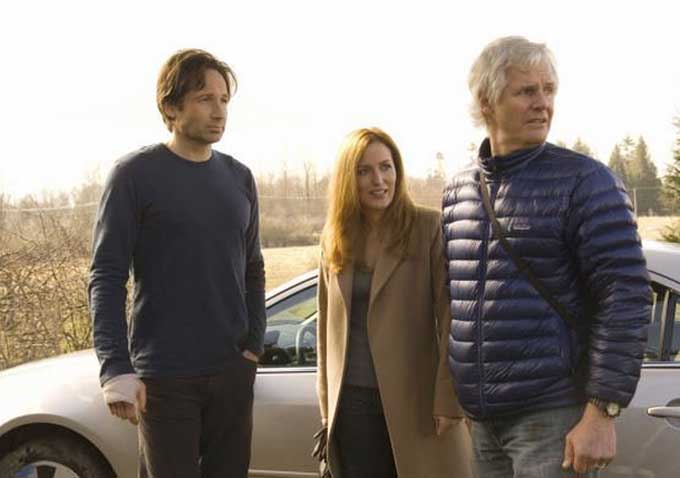By providing your information, you agree to our Terms of Use and our Privacy Policy. We use vendors that may also process your information to help provide our services. This site is protected by reCAPTCHA Enterprise and the Google Privacy Policy and Terms of Service apply.
‘X-Files’ Fans, Let’s Revisit Just How Bad ‘I Want to Believe’ Was

This post contains spoilers for “The X-Files: I Want to Believe.” But, also, maybe, that’s okay.
Even as reports went from offhand comments to active rumors to officially confirmed this spring, the news still didn’t feel real. “The X-Files” — for nearly a decade one of the offbeat crown jewels in Fox’s broadcast crown — would be returning for a new run of episodes. It was the sort of thing that might have been a joke at best a few years ago, impossible to imagine coming to pass. And even now, as photos from the set filter out across social media, cast members grow in number and teaser trailers pop up on YouTube, it’s still hard to believe that it’s really happening.
READ MORE: Watch: New ‘X-Files’ Footage Will Make You Believe This Is Actually Happening
But there are two types of “X-Files” fans in the world right now: The fans who freaked out with the official announcement, who look toward January 2016 with nothing but untempered enthusiasm… and the fans who saw, and remember, the franchise’s last on-screen adventure, “The X-Files: I Want to Believe.”
This weekend marks the seventh anniversary of the film “I Want to Believe,” which itself came out six years after what we then called the series finale of the show about two FBI agents investigating the paranormal. Which means it’s the seventh anniversary of many people realizing that not only was “The X-Files” a franchise that had aged beyond its prime, but maybe it should have remained silent since its unofficial end.
And that was actually really hard to face, for any fan of the series: The realization that Chris Carter, given the opportunity to tell a new story in the universe he created, featuring characters beloved by millions, would tell this story. And tell it badly.

Here’s the basic plot of the movie: An FBI agent has gone missing, and the circumstances of the case are weird enough for the FBI to track down Fox Mulder (David Duchovny), once one of the Bureau’s most brilliant if “out there” agents who is now basically hiding from the authorities after that thing where he maybe murdered a guy and also technically committed treason.
Mulder’s erstwhile partner in life, Dana Scully (Gillian Anderson), has quit the FBI to become a pediatric doctor and tells him that, according to the FBI, “all is forgiven” if he comes back to help solve this case. But the real incentive for Mulder is to escape the boredom of solitude and solve the mystery, which ends up boiling down to a man trying to Frankenstein his paralyzed husband a new (female?) body. In classic “X-Files” tradition, Mulder does so by basically blundering his way into the bad guys’ lair and getting captured, followed by a fortuitous rescue by Scully. Evil is thwarted, and Mulder and Scully live to investigate another day.
Beyond a few key details, the above plotline would not have felt extremely out of place as an episode of the show. In fact, it was specifically meant to emulate not the show’s ongoing and complicated alien conspiracy storyline, but the standalone “monster of the week” horror episodes that might not have advanced major plotlines, but are often remembered more fondly by fans. “The X-Files” is actually fascinating in this way, for on a historical level, it was television that bridged the gap between traditional procedurals and the sequential narratives that began rising in popularity in the late 1990s. So it was an interesting move for the franchise to use this chance at resurrection to remind people that “X-Files” was about more than aliens and the search for “the truth”; it was about something weird happening, and two very smart and attractive people figuring out what exactly that was.
Unfortunately, “I Want to Believe” is pretty bad, because “I Want to Believe” is fundamentally at odds with itself — straddling the awkward line between trying to recapture the show’s old magic and trying to find a new beginning for the franchise.
A significant thread to mention is the issue of Mulder’s sister, whose alien abduction as a child was the event that sent him down his life’s journey of investigating the paranormal. The tragedy of Samantha Mulder is first set up by a shot of her photograph in “I Want to Believe,” followed by, at about the 20 minute mark, FBI Agent Drummy (Xzibit) bluntly stating that “[Mulder’s] sister was abducted by E.T..” This is then followed up by Scully confronting Mulder about his desire to save people as an extension of the fact that he was never able to save his sister; it’s a pretty brutal moment, especially when followed up by Mulder’s line: “I’m trying to ignore you.”
 But beyond that, the film finds itself more oriented towards hardcore fans. Just one example: Our first scene featuring Mulder finds him in his home office, secluded from the world, as Scully confronts him with the news that the FBI will drop those pesky treason charges if he helps out with this case. Mulder’s unmoved, but Scully knows the real problem — that he’s bored out of his mind, something she communicates with a knowing glance at his office’s ceiling, which has become a literal dartboard for Mulder’s pencils.
But beyond that, the film finds itself more oriented towards hardcore fans. Just one example: Our first scene featuring Mulder finds him in his home office, secluded from the world, as Scully confronts him with the news that the FBI will drop those pesky treason charges if he helps out with this case. Mulder’s unmoved, but Scully knows the real problem — that he’s bored out of his mind, something she communicates with a knowing glance at his office’s ceiling, which has become a literal dartboard for Mulder’s pencils.
It’s a cute moment with the pair, but here’s the thing: The moment only really works if you remember the Season 5 episode “Chinga,” where Mulder, in the original basement office and bored out of his mind while Scully’s on vacation, ends up firing pencils at his ceiling. If you don’t remember that episode, Scully’s knowing glance might make some sort of vague sense in connection with the dialogue, but otherwise completely lacks significance.
Also, as beloved as Duchovny and Anderson might be when portraying their iconic characters, both of them seem like they’re wearing badly fitting suits after six years away, and even though their relationship has deliberately romantic overtones in the film (in direct opposition to the series, which fought against their chemistry for years to try to paint them as something resembling chaste) their connection feels fumbling.
Fumbling in general is a good word to use, like scrambling for a pen underneath the couch that you’re sure should be there because you saw it roll there… six years ago. Like, Scully’s own plotline is largely focused on her decision to escape the “darkness” (a word which gets used over and over again to reference the years she spent solving the weird crimes of the X-Files) by focusing on medicine. That decision still also tests her faith, largely because hell, anyone who spends a lot of time working to help desperately sick children will have a rough time of it. But it’s probably even rougher when the patient you want so badly to help is a boy the same age as the son you gave up for adoption, and is also named Christian, and you are treating him at a Catholic hospital.
And Scully’s questions about faith get caught up in the character of Father Joe (Billy Connolly), who is essentially the only real paranormal element of the film; a priest who is also a pedophile whose psychic connection helps Mulder track down the bad guys. As much respect as Connolly deserves for his career as a stand-up and performer, every moment of screen time given to his character feels like a waste.
Except that Father Joe does inspire in Scully a lot of personal doubts about her ability to “look into the darkness” anymore, after having left the FBI. “Look into the darkness” is a phrase that gets used a lot to communicate the fact that as seamlessly as Scully might slip into investigator mode during the film, she really does not want to be an FBI agent anymore. But as clearly as that point is communicated, Carter and co-writer Frank Spotnitz’s dialogue still leaves it feeling muddled:
Scully: As far away from the darkness as we can get?
Mulder: I’m not sure it works that way. I think maybe the darkness finds you and me.
Scully: I know it does.
Mulder: Let it try.
That’s from the second-to-last scene of the movie, which basically ends with Mulder offering to take her on vacation. They then kiss for the second time in this film about two heterosexual adults who have been in something like a committed relationship for about eight or nine years at least, and then Scully goes to perform the operation that in theory will save her patient Christian patient named Christian.
“The X-Files: I Want to Believe” is actually pretty romantic, at the end: The hero and heroine kiss, and commit to trying to make a new life. And the closing credits sequence proves essential to watch if you’re looking for full-on closure, because it features a dialogue-less shot of Mulder and Scully “escaping the darkness” on a calm blue ocean. On a rowboat. In swimsuits.
For all these years, that was the closest “X-Files” fans had to a happy ending. Until now. Now that ending is no longer an ending. Which brings its own sort of weirdness and its own level of concerns.
Here is the reason why it’s been worth devoting this time to beating up “I Want to Believe”: We are still waiting for signs that prove we’re not looking at a similar sort of disaster come January.
So far, at least a few of our initial conditions actually look locked in place: It’s a limited series, multiple writers and directors will be involved, and there’s an overarching narrative in place for the six episodes. And there’s chatter and gossip to indicate that there will be clarity when it comes to the exact nature of Mulder and Scully’s relationship, which is one of the most frustrating aspects of “I Want to Believe.”
Even the very few seconds we’ve gotten of the revival, featuring Mulder and Scully in action in suits with guns and flashlights, are reassuring. But as much as we want Mulder and Scully back, solving paranormal crime, we want it to be great. Because the tragedy of being an “X-Files” fan is knowing what it looks like when it isn’t.
READ MORE: 7 Groundbreaking ‘X-Files’ Episodes To Celebrate UFO Day
By providing your information, you agree to our Terms of Use and our Privacy Policy. We use vendors that may also process your information to help provide our services. This site is protected by reCAPTCHA Enterprise and the Google Privacy Policy and Terms of Service apply.


















